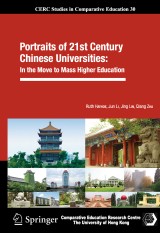Details

Portraits of 21st Century Chinese Universities:
In the Move to Mass Higher EducationCERC Studies in Comparative Education, Band 30
|
149,79 € |
|
| Verlag: | Springer |
| Format: | |
| Veröffentl.: | 03.12.2012 |
| ISBN/EAN: | 9789400727892 |
| Sprache: | englisch |
| Anzahl Seiten: | 488 |
Dieses eBook enthält ein Wasserzeichen.
Beschreibungen
<p>This book examines the ways in which China’s universities have changed in the dramatic move to a mass stage which has unfolded since the late 1990s. Twelve universities in different regions of the country are portrayed through the eyes of their students, faculty and leaders.</p><p><p>The book begins with the national level policy process around the move to mass higher education. This is followed by an analysis of the views of 2,300 students on the 12 campuses about how the changes have affected their learning experiences and civil society involvement. The 12 portraits in the next section are of three comprehensive universities, three education-related universities, three science and technology universities, and three newly emerging private universities. The final chapter sketches the contours of an emerging Chinese model of the university, and explores its connections to China’s longstanding scholarly traditions</p>
<p>List of Abbreviations.- List of Figures.- List of Tables.- List of Photos.- Foreword; <i>Robert F. A</i><i>RNOVE.- </i>Introduction and Acknowledgements; <i>Ruth H</i><i>AYHOE.- </i><b>PART I: Overview and Main Themes</b>.- <b>1</b><b>.</b> Understanding China’s Move to Mass Higher Education from a Policy Perspective; <i>Qiang Z</i><i>HA.- </i><b>2.</b> Equity, Institutional Change and Civil Society – The Student Experience in China’s Move to Mass Higher Education; <i>Jun L</i><i>I.- </i><b>PART II: Portraits of Three Public Comprehensive Universities.</b>- <b>3.</b> Peking University – Icon of Cultural Leadership; <i>Ruth H</i><i>AYHOE </i><i>and Qiang Z</i><i>HA</i><i>, with Y</i><i>AN </i><i>Fengqiao.- </i><b>4</b><b>.</b> Nanjing University – Redeeming the Past by Academic Merit; <i>Jun L</i><i>I </i><i>and Jing L</i><i>IN</i><i>, with G</i><i>ONG </i><i>Fang.- </i><b>5.</b> Xiamen University – A Southeastern Outlook; <i>Ruth H</i><i>AYHOE </i><i>and Qiang Z</i><i>HA</i><i>, with X</i><i>IE </i><i>Zuxu.- </i><b>PART III: Portraits of Three Education-Related Universities.</b>- <b>6.</b> East China Normal University – Education in the Lead; <i>Ruth H</i><i>AYHOE </i><i>and Qiang Z</i><i>HA</i><i>, with L</i><i>I </i><i>Mei.- </i><b>7.</b> Southwest University – An Unusual Merger and New Challenges; <i>Jun L</i><i>I </i><i>and Jing L</i><i>IN</i><i>, with L</i><i>IU </i><i>Yibin.- </i><b>8.</b> Yanbian University – Building a Niche through a Multicultural Identity; <i>Jing LIN and Jun LI, with PIAO Taizhu.- </i><b>PART IV: Portraits of Three Science and Technology Universities.</b>- <b>9.</b> The University of Science and Technology of China – Can the Caltech Model take Root in Chinese Soil?; <i>Qiang ZHA and Jun LI, with CHENG Xiaofang.- </i><b>10.</b> Huazhong University of Science and Technology – A Microcosm of New China’s Higher Education; <i>Ruth HAYHOE and Jun LI, with CHEN Min and ZHOU Guangli.- </i><b>11.</b> Northwest Agricultural and Forestry University – An Agricultural Multiversity?; <i>Qiang ZHA and Ruth HAYHOE, with NIU Hongtai.- </i><b>PART V: Portraits of Three Private Universities</b>.- <b>12.</b> Yellow River University of Science and Technology – Pioneer of Private Higher Education; <i>Ruth HAYHOE and Jing LIN, with TANG Baomei.- </i><b>13.</b> Xi’an International University – Transforming Fish into Dragons; <i>Jun LI and Jing LIN, with WANG Guan.- </i><b>14.</b> Blue Sky – A University for the Socially Marginalized; <i>Jing LIN and Qiang ZHA.- </i><b>PART VI: Conclusion and Future Directions.</b>- <b>15.</b> Is There an Emerging Chinese Model of the University?; <i>Qiang ZHA.- </i>Notes on the Authors.- Index.</p>
<b>Ruth Hayhoe</b> is a professor at the Ontario Institute for Studies in Education of the University of Toronto. <b>Jun Li</b> is an assistant professor in international education policy at the Hong Kong Institute of Education. <b>Jing Lin</b> is a professor of international education policy at the University of Maryland, College Park. <b>Qiang Zha</b> is an assistant professor at York University.
<p>This book examines the ways in which China’s universities have changed in the dramatic move to a mass stage which has unfolded since the late 1990s. Twelve universities in different regions of the country are portrayed through the eyes of their students, faculty and leaders. </p><p><p>The book begins with the national level policy process around the move to mass higher education. This is followed by an analysis of the views of 2,300 students on the 12 campuses about how the changes have affected their learning experiences and civil society involvement. The 12 portraits in the next section are of three comprehensive universities, three education-related universities, three science and technology universities, and three newly emerging private universities. The final chapter sketches the contours of an emerging Chinese model of the university, and explores its connections to China’s longstanding scholarly traditions.</p>
The views of contemporary students in Chinese universities on democracy, equity and civil society are presented, from a survey of over 2300 students 12 contemporary universities in all parts of the country, including three private universities are depicted, including their vision and mission, their orientation to the world and the innovations in curriculum and research Photos of favourite campus buildings and spaces, chosen by university leaders, faculty and students, are presented in each chapter – giving a lively sense of the habitat of contemporary universities in China Government policy making for education at the national and provincial levels, and the role of senior scholars in the process is portrayed Chinese civilization and Confucian values are made concrete through the drama of the stories of these universities, their famous scholars and leaders and their visions for contributing to global well being
Diese Produkte könnten Sie auch interessieren:

Bildungssysteme im Vergleich. Deutschland, die DDR, Schottland, Finnland und Japan

von: GRIN Verlag (Hrsg.), Rabea Hotaki, Jenny Braun, Veronika Amtmann

29,99 €

Die Bedeutung der Bewegung im Grundschulalter unter dem Aspekt der Motorik

von: Christopher Schuh

36,99 €

Cybermobbing in der Schule. Interventions- und Präventionsmaßnahmen, Erscheinungsformen sowie Ursachen

von: Katharina Zyban

13,99 €













